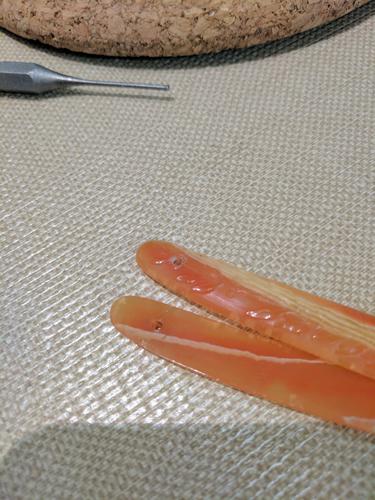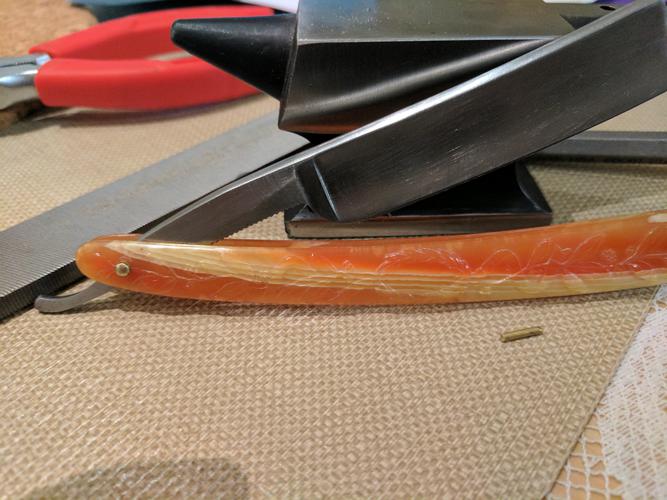Results 11 to 20 of 38
-
01-17-2017, 09:57 AM #11
 My first try at setting the bevel
My first try at setting the bevel
To the OP, if you're so inclined, you can easily measure the bevel angle. Search Google for the bevel angle calculator, it's an excel sheet with a formula. The width won't matter, as long as you're hitting the right angle zone.
Ink the bevel, as Euclid suggested, that will help you a lot.
Magnification... yes, you can get a cheap magnifier and it will help some. They are junk though. Ever since I got a 10x Bausch&Lomb loupe, with no lighting or anything, I never reach for anything else. It costs more, but it's well worth the price. Note that those numbers advertised on cheap magnifiers (30x, 60x etc..) are a lie. 10x B&L will tell you everything. The next thing you might want after that is a $500 microscope.Last edited by Srdjan; 01-17-2017 at 12:45 PM.
As the time passes, so we learn.
-
01-17-2017, 02:35 PM #12Senior Member



- Join Date
- Dec 2014
- Location
- Virginia, USA
- Posts
- 2,224
Thanked: 481
Like Cuda said, off topic and not a helpful tangent.
Height of the bevel is determined by blade geometry - set at the factory, and generally not something you'll change. As long as you aren't using so much pressure that you flex the blade, the height of the bevel is what it is.
-
-
01-17-2017, 03:28 PM #13

[QUOTE=cmsessa;1700920]Story behind this SR:
BeeJay honed me two razors and gave me one to try out myself.
Some pics of the work done:
1) Unpinning failing as usual. This is the only picture I have where you can see how the blade was:
Hello cmessa
Good information regarding bevel setting has been given, this is directed at pin removal. If you do not already use one you may want to invest in a Jeweler’s Anvil or Watchmakers Anvil (Google it). Lay the pin on top of the correct size hole when tapping out. Go with light taps. Many have cracked scales before so be glad they were not ivory. Hope this may help some.
MIke

Last edited by MODINE; 01-17-2017 at 03:36 PM.
-
The Following User Says Thank You to MODINE For This Useful Post:
Steel (01-18-2017)
-
01-17-2017, 04:32 PM #14Senior Member



- Join Date
- Apr 2012
- Location
- Diamond Bar, CA
- Posts
- 6,553
Thanked: 3215
Yes, regarding the unpinning, supporting the scales with something like a Jewelers anvil is good advice, but do not drive the pin all the way, through the scales. Cut or drill the head off one side of the pin, then lift the scale off the pin gently.
If you try to drive it through both scales and the pin is bent, just slightly or has a burr you will blow out the tip of the scale.
That type/style of scale is notorious for off gassing and can become very brittle, that may be the cause of the blade turning black and rusted in photo 1, where it would have sat in the scales.
You might also have trouble with it holding an edge, cell rot attacks the thinnest steel first, the edge. If you experience chipping you will have to remove metal, until you reach solid steel.
It does appear to have cleaned up nicely.
-
01-17-2017, 05:02 PM #15illegitimum non carborundum



- Join Date
- Jan 2008
- Location
- Rochester, MN
- Posts
- 11,552
- Blog Entries
- 1
Thanked: 3795
First, you would be much better off NOT honing the razor at all until you re-scale the blade. This is because a) it is easier to hone the razor with the scales in place and b) the task of re-scaling the razor is more dangerous for you if you are doing it with a sharp edge.
Second, the last photo shows that the tape has been cut through on the tang. There is no reason for the tang to ever make contact with the hone and doing so lifts the heel off of the stone, preventing it from being honed. The end of the heel should be as far as the razor should extend onto the hone.
-
The Following User Says Thank You to Utopian For This Useful Post:
cudarunner (01-17-2017)
-
01-17-2017, 05:38 PM #16
-
The Following User Says Thank You to Maarten For This Useful Post:
cmsessa (01-19-2017)
-
01-17-2017, 11:03 PM #17

Hey cmsessa. The size of the bevel doesn't matter as long as the edge is fully set. A small even bevel is much better looking though.
You want to be sure that the bevel is fully set from heel to toe. Do some test to make sure that there are no spots that need more attention. I like to use the TNT for this but things like magnification and other test will also work.
I use a cheap jewelers loupe that I got from eBay. Anything in the 30x-60x range will work.
When you are confident that the bevel is fully set, do some light strokes on the 1k to lighten up the 1k scratches. This will reruce the amount of work that you have to do on the on the next stone.
After the 1k go to the 4K until all of the 1k scratches are gone.
Let me know if you want to get together sometime. I can show you this stuff a lot easier in person.B.J.
-
The Following 2 Users Say Thank You to BeJay For This Useful Post:
cmsessa (01-19-2017), cudarunner (01-17-2017)
-
01-22-2017, 10:32 PM #18
-
01-22-2017, 10:34 PM #19illegitimum non carborundum



- Join Date
- Jan 2008
- Location
- Rochester, MN
- Posts
- 11,552
- Blog Entries
- 1
Thanked: 3795
Getting help in person is extremely helpful. Direct and immediate feedback goes way beyond what you can learn in a video.
-
01-23-2017, 05:16 AM #20

The acetone worked great!
I cleaned the scales and I got some acetone 99.5%.
Instead of using a qtip I used a syringe. I placed a couple of drops and hold it together for a couple of seconds.
Great results:


I already pinned the razor:




 56Likes
56Likes LinkBack URL
LinkBack URL About LinkBacks
About LinkBacks






 Reply With Quote
Reply With Quote


